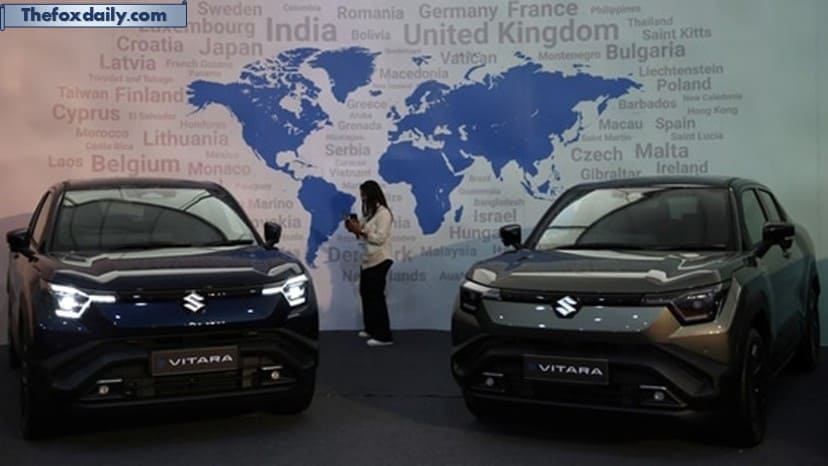
The first Suzuki e-Vitara to leave the factory is flagged off by the Indian prime minister, marking a significant milestone for the nation’s EV manufacturing capabilities. The Suzuki Motor Plant in Hansalpur, Gujarat, will transport the e-Vitara to 100 nations, including the UK, where the first unit will be exported.
India has been the focal point of Suzuki’s global BEV ambitions ever since the e-Vitara was introduced at the Bharat Mobility Global Expo 2025 in New Delhi. Often questioned for its late entry into the EV market, Suzuki Motor Corp. has nonetheless shown sound strategy by creating a born-electric platform that was—right from the start—designed and engineered for markets beyond domestic ones, including highly competitive ones such as Japan and Europe.
Suzuki’s statement represents a significant demonstration of confidence in India’s EV production capabilities at a time when regional industry leaders like Tata Motors Ltd. and Mahindra & Mahindra Ltd. are still developing plans to export their electric cars to markets like the UK and Europe. Especially when you take into account that South Africa has been added to the list of Tata Motors’ export markets, which were previously restricted to Sri Lanka, Nepal, and Mauritius, after a six-year break. What makes the e-Vitara unique, then?
A platform with multi-brand potential that is born-electric
According to a 2024 Reuters story, Suzuki led the development of the platform that supports the e-Vitara, which was co-developed by Toyota Motor Corp., Daihatsu, and Suzuki. In essence, a tri-party partnership produced the BEV’s skateboard architecture, e-axle, and battery integration, while Suzuki developed the vehicle’s design, electronics, features, and other components. It’s this tri-party venture that lends the e-Vitara its export worthiness, while the plant gives it the sort of scalability that even domestic market leaders like Tata Motors and Mahindra do not possess.
The Suzuki e-Vitara will be offered with front-wheel drive and AWD (Suzuki’s exclusive AllGrip technology) in two main variants, with 49 kWh and 61 kWh battery packs. Additionally, it will once more be rebranded as Toyota’s Urban Cruiser EV, utilizing Suzuki’s Heartect-e platform. The platform itself is based on Suzuki’s lightweight Heartect platform, which has been modified to incorporate a battery into a skateboard design.
Toyota, the largest automaker in the world by sales, had to show its strength and make sure the platform complied with ASEAN NCAP, EuroNCAP, and strict Japanese crash regulations in order for the product to be globally homologated. This allowed the car to be sold internationally. Toyota also contributed to the development of the battery management system by drawing on its work on LFP safety regulations.
electrodes made at home; imported batteries
In his post on X, the prime minister highlights the importance of the Hansalpur plant’s capacity to manufacture batteries, referring to the creation of hybrid battery electrodes as “a big boost to our battery ecosystem.”
It’s crucial to draw attention to the fact that, in contrast to the Suzuki e-Vitara, which is largely domestically produced, including the battery electrode, the electric SUV will still use imported battery cell packs, particularly those developed by the Chinese EV behemoth BYD, which is well-known for its state-of-the-art “Blade” type of lithium-ion phosphate batteries.
However, the manufacturing of electrodes by a mass market manufacturer is a major step towards supply chain independence.
The local production of the electrode—the positive (cathode) and negative (anode) layers that store and release lithium ions during charging and discharging—”will definitely give a boost to the EV segment,” said Vikram Handa, MD of Epsilon Advanced Materials.
The next query, then, is whether they are purchasing the cathode and anode from India. Battery manufacturers used to purchase coated foil from China and just apply powder to it in India. Both the foil and the powder must be produced in India, in my opinion, for the supply chain to truly flourish, Handa says.
According to Handa, the entire electrode has so far been supplied from China, just as a large portion of the EV supply chain. Handa emphasizes the significance of producing the battery electrode locally while warning against becoming overly dependent on China.
The issue is that customers are moving to China because of its cheap prices and surplus capacity. However, there is a lot of stickiness in the supply chain, which is the problem. Say, they are buying a product at $5 and I’m selling it $6, naturally they don’t want to buy it from me,” says Handa, whose company specialises in manufacturing anodes and cathodes for battery makers with the plan of setting-up a 2,000-tonne anode and cathode plant in India.
“But the problem is that you can’t change the supply chain during the lifecycle of a particular model of car or scooter, so even two years later, if the Chinese product has gone up to $8 and I’m at $5, they can’t buy it from me. You’re stuck for roughly six years.
The production of a localized electrode makes it more likely that battery manufacturers will source anodes and cathodes locally. Although the nation is still a long way from producing battery cells on a large scale, electrode manufacturing significantly improves the EV supply chain.
For breaking news and live news updates, like us on Facebook or follow us on Twitter and Instagram. Read more on Latest Business on thefoxdaily.com.

COMMENTS 0